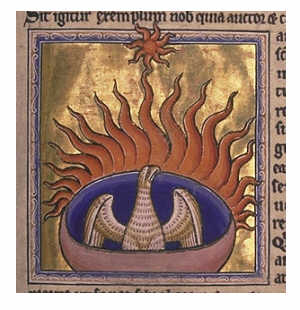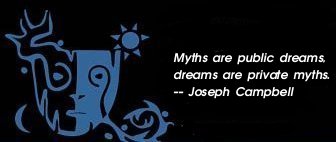|

The Phoenix
© 2009 by by Honora Foah
Co-president — Mythic Imagination Institute
Image: Phoenix from the Aberdeen Beastiary
 The world is indeed full of peril, and in it there are many dark places; but still there is much that is fair; and though in all lands love is now mingled with grief, it grows perhaps the greater. The world is indeed full of peril, and in it there are many dark places; but still there is much that is fair; and though in all lands love is now mingled with grief, it grows perhaps the greater.
— J.R.R. Tolkien, The Fellowship of the Ring
...demonism and creativity are psychologically very close to each other. Nothing in the human psyche is more destructive than unrealized, unconscious creative impulses....[W]hen it is a question of a mass psychosis, nothing but new, creative, 'redemptive' archetypal conceptions, brought up from the depths, can stop the development toward a catastrophe.
— Marie-Louise von Franz
What if you were the only one? We imagine her burning nest, the self-immolation of the great bird — but, she lives 100 years, so they say — some say 500. And only one. What is she doing all of that time before she builds her pyre?
I'm trying to write about the phoenix because Mythic Passages has been down since February 2008 and with this issue, there is a renewal of Mythic Imagination. I keep trying to write about the phoenix, but have you seen the newspaper lately? I can't get to the phoenix before I crawl across the wreckage of the economy, and it turns out they are of a piece.
I'm trying to write about the phoenix, the bird of the sun, the bird of beautiful song who brings fire to the sun altar every day, yet all I can think about is how lonely she is. The firebird is ever self-renewing, but there is only one alive at a time. All I can think about is community.
The theme of the last session of the Applied Mythology Certificate Program was Community. Mythology is first and foremost a cultural/social form. Its homeland is not with the individual, nor is it universal. It is deeply held by individuals, it shapes and teaches persons, but the first task of mythologies is to form communities. The stories have universal spiritual truths, universal psychological truths and transcendent elements but they are clothed in a particular native costume and moral sensibility. Joseph Campbell and many others have done wonderful work drawing out these universal threads, but we lose the absolute core of mythological purpose if that is all we see.
As we watch the American economy melt down, the importance of the culturally held structure becomes alarmingly clear. Bear with me here. What has happened to the banks is not that they have lost so much value. What they have lost is credibility and therefore credit. Since currency only exists and works as a current — that is, it has to be alive and flowing, when credit freezes — in a way, currency ceases to exist. The technical economic term for the current is 'liquidity'. And we ain't got it.
Money only exists as an agreement. We agree on a value and then act as if it were true. There is no absolute value of anything, it is just an agreement of what we will pay for something. What is happening now is not that the foreclosed houses or the stocks or the banks have no value, it is that we cannot figure out what the value is; we cannot come to an agreement. Money is the mythology of our time — on every single level of our existence — including this very basic physical level of exchange rate, valuation etc. Value is a shared story.
Mythology/shared story is the basis of group formation. Human beings must have each other for survival. We are not like tigers who roam and hunt singly. As I watch the economic news, my tactical response is to brainstorm about sharing. How can my family/friends/community help each other more, so that our resources can go farther? And in fact, in the most bottom-line way, this works. A car pool is absolutely less gas money. But to really be able to share, the necessity of the bottom line has to be united with the heart. A common story about what we are doing can hold us together when the aggravation of the shared car, the adjusted time schedule and the compounded mistakes of living with other people make us want to give up and get out, or simply scream.
Not everyone looks at this endless horizon of war and economic chaos and thinks, "We need more mythological literacy". But when you think about it, that's exactly what we need. What are these religious wars but the clash of overly literalized mythologies? What is a run on the bank but a garbled story that creates distrust and panic?
What has this got to do with the phoenix? I wanted to write about the phoenix because Mythic Passages, this magazine, has been on hiatus since last February, and it, as the voice and central switchboard of the Mythic Imagination community, is coming back to life in a renewed form and with renewed purpose. Mythic Imagination Institute has other projects coming to life and we wanted to report on them. Enter the Phoenix.
What are they like?
In ancient Egypt, the phoenix, Bennu, was sprung from the heart of Osiris, the dying and resurrecting god and called 'the soul of Ra', the god of the sun.
The firebird is gold and red and orange. In the Russian stories, even one feather from the bird can light an enormous room.
When the new phoenix is born from the ashes of the old, it then gathers those ashes, mixes them with myrrh and brings them to the altar of the sun in Heliopolis.
In Jewish folklore, it is said that the phoenix was the only animal not to join Adam in his banishment from the Garden of Eden.
All of these images are evocative, for me, especially this last, about the phoenix being the lone inhabitant still of the Garden of Eden. Would you want to be even in Paradise, if you were always alone? Adam didn't. He complained. Oy!
As I began to look at the phoenix, I got interested in the word, which made me think of Leto's children, Phoebus, the Sun and Phoebe, the Moon, Apollo and Artemis. Phoibus is Greek for radiant, bright, pure. So here is the phoenix, the sun, the servant of the sun, with a faithfulness that always goes the full length, through and beyond death to return to us again.
This faithfulness of the Bright, who sends his sister to comfort and remind us even when he is gone, is the essence of the will to live. When we go through a night so dark it doesn't seem possible to continue, there is still deep down in the knowledge of the bones, the remembrance of Phoebus and his promise, a promise he has never ever failed to keep since the beginning of the world.
The Egyptians pictured Ra, the sun, in his boat that had to sail upside down through the underworld each and every night. I have been talking with Janet Pietalato, the guest teacher for October's Applied Mythology session, about how the full community is of the living and the dead, of both of Ra's worlds.
There is a great shaking now. All of the investment banks in the United States are gone, either failed or turned into some other sort of bank. These are the very same institutions that until a couple of weeks ago have been driving the economy for the last few decades. They have fallen as suddenly as the World Trade Towers. The World Trade Towers were chosen as a target specifically to signal attack on the Western economy because the attackers knew that this is the heart of our mythology.
The World Trade Center is ash, the people in it are ash, immolated. The investment banks are gone. There will be many attempts to fix it, and they will be more or less successful, but the fact is, we cannot go back. The cup, as Sobonfu Some said at Mythic Journeys, and as she says in the film that is soon to come out about Mythic Journeys, the cup is broken. It is gone; mourn.
Within the ash of the phoenix nest, an egg appears. A red egg. After the bird is grown enough, she mixes the ash with myrrh, a resin of purification and preservation, and brings it to the altar of the Sun. Even immolation has not completed the purification or the journey of the ash. It must be brought to Phoebus' altar and offered up.
Whatever is to be newly made here in our culture requires a powerful, powerful mythic imagination of our next life. And though I am talking about something mythic and vast, profound and far-reaching, my own suspicion is that what is required partakes of the very small and humble. In some stories, what is born from the phoenix egg is a little tiny worm.
I have written and spoken often about the experience of the Mythic Imagination community. The Mythic Journeys conferences, this magazine, the Applied Mythology Program and other projects keep rising up from these nested circles of people who have gathered in a common story. That story lives differently in each one, but all feel deeply the importance of myth, story, metaphor and the imaginal worlds. Without the stories we need, our communities fall apart. Without the nurturance of the 'world behind the world' (as Michael Meade says), we personally have no support, we cannot find the contributions we need to bring to each other. Inside these individual stories is the food that we bring to the communion that sustains our communities.
Every life is a story and a story can change the world.
Return to Mythic Passages Menu
Subscribe to the Mythic Passages e-magazine
|

